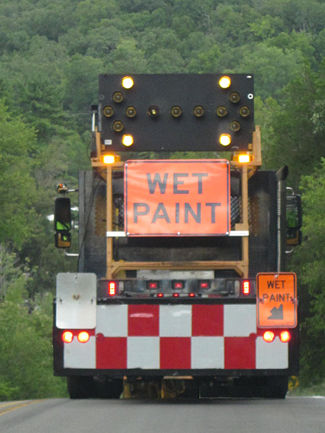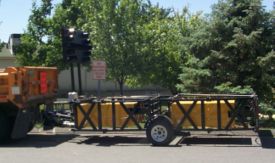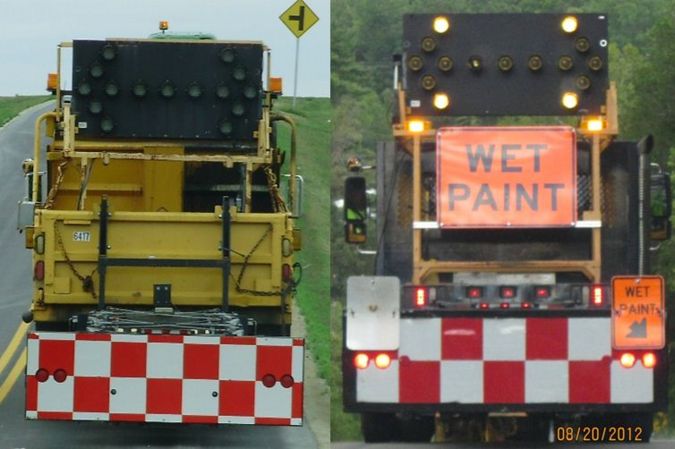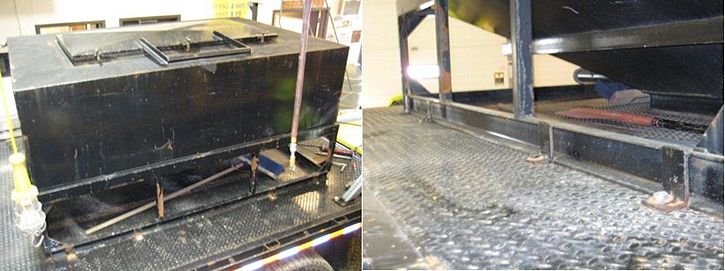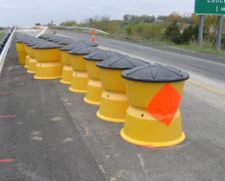Difference between revisions of "Category:612 Impact Attenuators"
(→612.1 Protective Vehicles (MUTCD "Shadow Vehicle"): added table of pros and cons) |
|||
| Line 18: | Line 18: | ||
{| border="1" class="wikitable" style="margin: 1em auto 1em auto" align="right" | {| border="1" class="wikitable" style="margin: 1em auto 1em auto" align="right" | ||
| − | |+ '''''[[media | + | |+ '''''[[media:612.xlsx|Pros and Cons of Truck- and Trailer-Mounted TMAs]]''''' |
|- | |- | ||
! style="background:#BEBEBE" colspan="2"|Truck-Mounted TMA <br> Host Vehicle 16,000 lbs GVWR !! style="background:#BEBEBE" width="5"| !! style="background:#BEBEBE" colspan="2"|Trailer-Mounted TMA <br> Host Vehicle 10,000 lbs GVWR | ! style="background:#BEBEBE" colspan="2"|Truck-Mounted TMA <br> Host Vehicle 16,000 lbs GVWR !! style="background:#BEBEBE" width="5"| !! style="background:#BEBEBE" colspan="2"|Trailer-Mounted TMA <br> Host Vehicle 10,000 lbs GVWR | ||
Revision as of 07:08, 31 October 2013
| Safety Videos |
| TMA Safety Points |
This article provides information of the use of protective vehicles and three primary types of impact attenuators: truck-mounted attenuators, trailer-mounted attenuators and freestanding impact attenuators (sand barrels). Impact attenuators are designed to absorb energy of an impacting vehicle and reduce the force on a passenger to an acceptable level.
Contents
- 1 612.1 Protective Vehicles (MUTCD "Shadow Vehicle")
- 2 612.2 Sand-Filled Impact Attenuators (Sand Barrels)
- 3 612.3 Construction Inspection Guidelines for Sec 612
612.1 Protective Vehicles (MUTCD "Shadow Vehicle")
Protective vehicles are used to safeguard the workspace from errant vehicles. In some operations, these devices also serve as platforms for signs and other devices used to warn traffic of upcoming conditions or inform them of needed actions. For increased motorist, driver and worker safety, the protective vehicle may be equipped with a truck-mounted attenuator.
| Truck-Mounted TMA Host Vehicle 16,000 lbs GVWR |
Trailer-Mounted TMA Host Vehicle 10,000 lbs GVWR | |||
|---|---|---|---|---|
| Pros | Cons | Pros | Cons | |
| Cost and Maintenance | Cost and Maintenance | |||
| After an impact the TMA is easily secured to the host truck, for transport to shop (Ex: no need for a tow truck) | After impact, damage to host truck is common and extended down time of truck is possible. This may be an issue if the vehicle fleet in an area is low. | For the "boat" trailer style, the TMA normally has less parts, maintenance cost, and assembly cost. | Tire issues can cause down time | |
| No tire maintenance or down time due to tire issues | Maintenance can be costly and timely | - | - | |
| - | TMA must be removed prior to Arrow Board maintenance or repairs | - | - | |
| Operations | Operations | |||
| Follows directly behind truck (Ex: Will not track paint from striping operations) | Difficult to remove and install. (Ex: Truck can not be quickly used for other applications) | Trailer TMA are usually easier to install and remove from the truck hitches. | The driver may have difficulties backing, which a spotter is recommended. (Ex: Backing up to pick up channelizers within a work zone and keeping the trailer out of the travel lane) | |
| Easy Backing when spotter not available (Ex: During work zone removal) | Difficult to access plugs, wires and lighting connections during installation and removal | After an impact, the trailer is removed from host vehicle and the truck is usually still serviceable. | After impact trailer need requires being towed by flat bed back to shop for repairs | |
| Easy Maneuvering | Truck may not have hitch. This may limit the number of applications of the truck. | - | During operations such as striping, tires can track paint | |
| - | When in down position TMA will swing in to adjacent lane | - | Finding a location to turn around can be difficult (Ex: Rural areas with narrow lanes, small entrances, etc.) | |
| Other Considerations | Other Considerations | |||
| - | Overhead hazards become an issue when the TMA is in the Up position, which reaches 13'6". | When the TMA is not deployed as a protective truck, the tailgate can be left attached for cargo/material hauling. | Depending on TMA , the unit may rotate into an adjacent lane upon a side impact. | |
| - | Due to added weight of the TMA on rear of the truck, the ride is rough and is tough on truck suspension. | The TMA can be use with different host vehicles and is not dedicated to one vehicle. | Some trailer TMAs look similar to "boat" trailers, which gives a perception the TMA units not being safe. | |
| - | Due to the over swing and lowering of the TMA, the area behind the truck should be clear of personnel and vehicles. | - | - | |
612.1.1 Truck- and Trailer-Mounted Attenuators
Truck-mounted attenuators (TMAs) are energy-absorbing devices attached to the rear of the trucks used as protective vehicles, thus protecting the motorist and the protective vehicle's driver upon impact.
The National Cooperative Highway Research Project and AASHTO Manual for Assessing Safety Hardware (MASH) tests and sets crash criteria for TMAs. TMAs purchased by MoDOT meet these requirements.
Damaged TMAs are to be removed from service and either repaired or replaced.
The NCHRP crash tests were straight-on and offset collisions, not side impacts. TMAs are not designed for side impacts.
Articles on MoDOT's truck-mounted attenuator training and Maintenance Planning Guidelines for Impact Attenuators are also available.
612.1.2 Protective Vehicle/TMA Operations
The term "protective vehicle" represents the use of the protective vehicle within operations. The term TMA represents a truck or trailer-mounted attenuator may be warranted depending on the operation being performed.
612.1.2.1 Protective Vehicle/TMA Positioning
Proper positioning of the protective vehicle/ TMA vehicle within the work zone is critical to its effectiveness. As an operator, it is the operator responsibility to make sure that the protective vehicle/TMA is in the proper position to protect the crew, to provide ample roll-ahead distance, and to provide adequate warning to your co-workers and traveling public.
612.1.2.2 TMA Typical Operations
612.1.2.2.1 Stationary Operation
During Stationary Operations, all protective vehicle/TMA vehicles shall be parked with the transmission in neutral and the parking brake engaged. The vehicle shall maintain at least 150 feet roll ahead distance to the next vehicle or work activity, be parallel to traffic, and have its wheels aligned with the striping and lane so as to maintain lane discipline and try to stay within the lane if struck. The operator shall not wait inside or near the protective vehicle/TMA vehicle. The employee should proceed to the Work Space to assist other employees and wait for instructions.
For additional guidance for protective vehicle/TMA usage within work zones, refer to the typical applications in EPG 616.8 Typical Applications.
612.1.2.2.2 Mobile Operations
Mobile operations is work that moves intermittently or continuously and occupies a location up to 15 minutes in duration.
During mobile operations, protective vehicle/TMA operators are allowed to take preventive action when they perceive possible interaction with an errant vehicle. Preventive action includes moving the protective vehicle/TMA forward to lessen impact. If the operator takes preventive action, he/she should be observant of all crew workers and equipment to maintain at least 150 feet roll-ahead distance and stay in the closed lane. In instances where you do not have the recommended 150 ft. roll-ahead distance, DO NOT roll forward to lessen the impact and, if possible, engage the parking brake.
Primary protective vehicle/TMAs during Mobile Operations, if any employees exit their vehicles in the work activity, the protective vehicle/TMA operator closest to work activity shall engage the parking brake. Typically that vehicle maintains 150 feet roll ahead distance to the work activity, be parallel to traffic, and have its wheels aligned to stay within the lane if struck. If the operator of the protective vehicle/TMA closest to the work activity feels he/she is about to be struck by an oncoming vehicle, he/she may take preventive action if the roll-ahead distance is greater than 150 feet.
Secondary protective vehicle/TMAs during Mobile Operations, if an operator feels he/she is about to be struck by an oncoming vehicle, the operators may take preventive action as to lessen the impact. However, the operator shall maintain at least 150 feet roll ahead distance to the next protective vehicle/TMA, be parallel to traffic, and have its wheels aligned to stay within the lane if struck.
For additional guidance for protective vehicle/TMA usage within work zones, refer to the typical applications in EPG 616.8 Typical Applications.
612.1.3 MoDOT Protective Vehicle/TMA Guidelines
Lighting. All lighting should be appropriately set, depending on the day or nighttime conditions.
The Light Bar and Emergency Alert lights on the Rear Advanced Warning Truck should be used for striping and sweeping operations and are optional on other mobile operations in accordance with typical applications. If used, the rear facing amber/white light bar is installed on top of the vehicle and the Emergency Alert lights are installed below the flashing arrow panel.
If an approaching vehicle is observed driving in the occupied moving work zone lane the TMA driver should activate the Emergency Alert Lights by pushing the switch for a short duration. It is not recommended to leave the lights on very long because continuous or long term use may reduce the effectiveness of the emergency alert lights.
Rear Face of TMA. The rear face of the attenuator device, when in the horizontal or operating position (protective mode), shall be marked with red and white retroreflective sheeting. The marking shall form a checkerboard pattern consisting of 12” by 12” red squares and 12” by 12” white squares spaced symmetrically starting from the top center.
Vehicle Size. On MoDOT’s maintenance operations where the normal posted speed limit is 60 mph or greater, the host vehicle shall be a Heavy-Duty Single Axle Truck style, or heavier, and meet the truck-mounted and trailer-mounted attenuator manufacturer’s recommendations.
Incident Response. For incident response operations, a vehicle with a truck/trailer-mounted attenuator is not required. If used, the host vehicle shall meet the truck/trailer-mounted attenuator manufacturer’s recommendations.
612.1.4 MoDOT Equipment/Materials Stored in Bed of Protective Vehicle Guidelines
Loads or cargo, such as sign posts, tools, may be moved to and from work areas in the bed of the protective vehicle/TMA, but must be removed when protective vehicle/TMA is deployed for protection or has the possibility of deployment prior to getting to the work area. Truck beds may be secured to the truck frame to maximize stability during impact. Steel plates and/or containers, secured by approved methods, may be used for ballast or weight to keep the dump bed against the host vehicle frame may remain in the vehicle while the protective vehicle/TMA is deployed. Loads or cargo are not allowed to be carried on trailer type TMAs.
612.1.5 MoDOT Protective Vehicle/TMA Operator’s Training
It is the protective vehicle/ TMA operator’s responsibility to protect workers from approaching traffic. The operator needs to be observant of the surrounding area at all times, checking mirrors regularly for any oncoming hazards and warn the crew immediately should the need arise. This training will be conducted in two stages:
- Stage 1 – Classroom General Knowledge Training
- Stage 2 – OJT (On the Job) Training and Skills Assessment.
612.2 Sand-Filled Impact Attenuators (Sand Barrels)
This system consists of a group of freestanding plastic barrels configured in increasing weights from the impact point toward the object. Such an array transfers the vehicle’s momentum to the increasing masses of sand in the barrels and provides a gradual deceleration. Each barrel is designed with a specific weight of sand to absorb the energy of an errant vehicle. The sand barrel array's "footprint" length and width and the number of barrels will change based upon the vehicle speed. Refer to Standard Plan 612.20 for details. When specified, quantities are calculated and shown on the plans. No direct payment is made for the Type 1 object marker on the lead module. An estimate for replacement barrels needs to be included as a separate pay item, typically calculated as one for every ten barrels.
Sand barrels are most often used to shield fixed objects that cannot be removed or relocated. Sand barrels are recommended for temporary usage such as in work zones. A benefit/cost analysis is to be conducted before sand barrels are used in a permanent application.
An approved sand-filled impact attenuator may be installed on the exposed end of the barrier where the posted speed prior to construction on an existing facility or the anticipated posted speed of a temporary facility is greater than 35 mph. A crash cushion will be required on the upstream end for divided facilities, and on both ends for all two-way facilities. Crash cushions are discussed in EPG 617.1.4 Crash Cushion. Applicable pay items are included in the plans.
Crashworthy end terminals (Types A through E) should be used when sufficient width is not available for sand barrels. More information on proprietary crash cushions is available at EPG 617.1.3.3 Crash Cushion.
612.3 Construction Inspection Guidelines for Sec 612
Material (for Sec 612.2) Certifications are to be collected on both the sand and retroreflective sheeting used in or on the sand-filled impact attenuators.
Safety Requirements (for Sec 612.3) The inspector is to request a copy of the manufacturer’s certification that states the units comply with the crash test requirements of NCHRP 350, Test Level 3, and have FHWA acceptance. This information is to be kept in the project files.
Construction Requirements (for Sec 612.4)
Truck-Mounted Attenuator (for Sec 612.4.1) TMAs are to be inspected to make sure they are structurally sound, the frames are not bent and that they appear to be in good working order. In some cases, the contractor may elect to add TMAs when TMAs are not required. Even elective TMAs need to be NCHRP 350 compliant so the certification still needs to be collected. Typically, TMAs are only required and paid for under conditions where the contractor is operating without a lane drop set up (cones, channelizers, etc.). TMAs that the contractor voluntarily adds to an operation are typically not paid for.
Sand-Filled Impact Attenuator (for Sec 612.4.2) The inspector is to request a copy of the manufacturer’s installation instructions for whatever particular brand of sand-filled impact attenuator the contractor is using. When inspecting the sand-filled impact attenuator arrays, make sure that the array is set up as shown in the standard plans and filled in accordance with the manufacturer’s recommendations. All lids are to be on and secured. MoDOT requires rock salt intermixed with the sand so that any water that gets into the barrels will not freeze and create a safety hazard. When checking the contents of the barrels, rock salt should be visible in the sand mix. During periods of extended cold weather, the sand should be checked periodically to make sure it hasn’t frozen because the salt content has been exhausted. If this condition is found, the contractor will need to add more salt or replace the sand/salt mixture.
